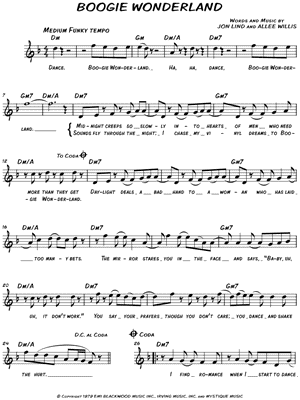Quote:
Originally Posted by washy21

Thanks,
I kind of feel that the stumbling block are issues such as rests and tied notes but possibly the best way forward is to get stuck into a program and try it.
|
I suggest - along with any theoretical study or working with a program - buying a songbook of songs that you know. Look at how those familiar melodies are notated. How do they use ties and rests?
You'll find lots in vocal melodies of pop and rock songs, maybe fewer in melodies of classical, folk or jazz tunes. That's because pop and rock vocals are usually transcribed from recordings, retaining all the phrasing used which often includes syncopation, which usually requires ties. Classical, folk and jazz tunes often have the melodies simplified so all the notes are on the beat, and ties are rarely needed.
Here's a tune in which the vocal is almost entirely syncopated:

So, lots of rests, ties and slurs.
Rests obviously indicate periods of silence, and have similar values to notes - notes and rests have to add up to the value of the bar (4 beats in this case). So the first bar has a one-beat note (quarter note), followed by a quarter-note rest and a half-note rest. Then bar 2 starts with a half-note rest before the four 8th notes.
Bar 3 has a "slur", a curved line joining two different notes. This is because the two notes cover one syllable, "la-and". Again, rests equivalent to an 8th and half note complete the bar. Notice they go in that order, and not half-note followed by 8th note - this is so the half-way point in the bar is clear. Notes and rests should never cross over beat 3.)
Bars 7-8 contain a single note stretched over two bars. I.e., the singers hold the syllable "land" for 7 quarter notes. That's what the "tie" indicates: joining the whole note to the dotted half-note. (Then a quarter note rest to allow the singer(s) to take a breath!)
The melody is then almost all in 8th notes, sometimes separated by rests (some of which are not totally necessary, see below), sometimes joined by slurs (one syllable two notes), sometimes ties (same note extended across a barline, or across beat 3.)
The phrase "mid-night creeps" could have a quarter note on "night" instead of the 8th note and 8th rest. The way they've shown it indicates a break before "creeps", of course, suggesting the singer should sing "night" shorter than he might usually. Singing this phrase more naturally wouldn't need all those rests (no need to actually breathe that often!), so this is a stylistic thing - a distinctively "staccato" effect.
The syllables "slow-" and "hearts" are syncopated - normally they'd fall on beat 1 of the bar, but are brought forward and then sustained across the barline - hence the need for the ties.
The syllable "in-" in bar 10 is two tied 8th notes; i.e., it would sound like a quarter note, but crosses beat 3, so needs to be shown as two 8ths: the second 8th is on beat 3, underlining that the syllable is syncopated - starts before the beat and holds across it. In a sense this is more complicated than a simple quarter note, but makes the timing easier to read.
NB: this is an extreme example! Very few vocal melodies would actually need notating this fussily. The point is just to show how ties, slurs and rests are employed.